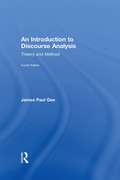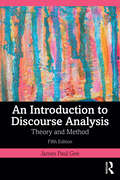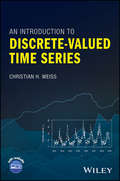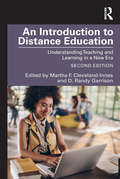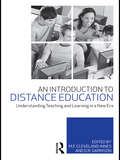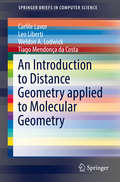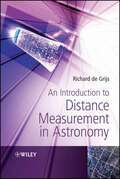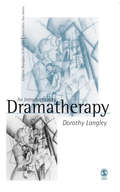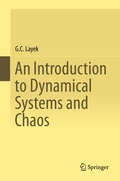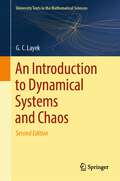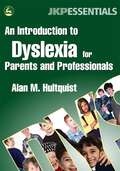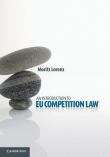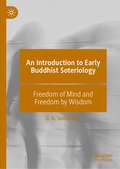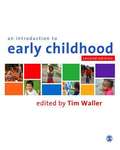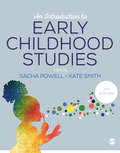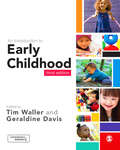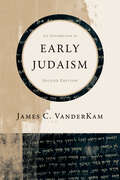- Table View
- List View
An Introduction to Discourse Analysis: Theory and Method
by James Paul GeeDiscourse analysis considers how language, both spoken and written, enacts social and cultural perspectives and identities. Assuming no prior knowledge of linguistics, An Introduction to Discourse Analysis examines the field and presents James Paul Gee's unique integrated approach which incorporates both a theory of language-in-use and a method of research. An Introduction to Discourse Analysis can be used as a stand-alone textbook or ideally used in conjunction with the practical companion title How to do Discourse Analysis: A Toolkit. Together they provide the complete resource for students studying discourse analysis. Updated throughout, the fourth edition of this seminal textbook also includes two new chapters: 'What is Discourse?' to further understanding of the topic, as well as a new concluding section. A new companion website www.routledge.com/cw/gee features a frequently asked questions section, additional tasks to support understanding, a glossary and free access to journal articles by James Paul Gee. Clearly structured and written in a highly accessible style, An Introduction to Discourse Analysis includes perspectives from a variety of approaches and disciplines, including applied linguistics, education, psychology, anthropology and communication to help students and scholars from a range of backgrounds to formulate their own views on discourse and engage in their own discourse analysis. This is an essential textbook for all advanced undergraduate and postgraduate students of discourse analysis.
An Introduction to Discourse Analysis: Theory and Method
by James Paul GeeThis bestselling textbook provides a comprehensive guide to conducting discourse analysis. The book outlines Gee’s approach, which involves examining how language is used in context to construct meaning, identities, relationships, and social practices.The theoretical framework is built around seven "building tasks" that language performs: significance, practices, identities, relationships, politics, connections, and sign systems and knowledge. Gee introduces six "tools of inquiry" for analyzing these tasks: situated meanings, social languages, figured worlds, intertextuality, Discourses, and Conversations.Methodologically, Gee emphasizes the importance of context and the reciprocal relationship between language and context. He discusses transcription, outlines the components of an "ideal" discourse analysis, and addresses issues of validity.The book provides practical guidance on analyzing various aspects of language, such as intonation units, stanzas, and the overall organization of oral and written texts. Gee uses interview data to demonstrate how identities and socially situated meanings are constructed through language.This new edition is updated throughout with new examples and a new chapter on multimodal discourse analysis, demonstrating how Gee’s approach can be applied to texts that combine language with other modes of communication, like images or video. Overall, the book equips readers with a robust toolkit for systematically analyzing discourse.
An Introduction to Discrete-Valued Time Series
by Christian H. WeissA much-needed introduction to the field of discrete-valued time series, with a focus on count-data time series Time series analysis is an essential tool in a wide array of fields, including business, economics, computer science, epidemiology, finance, manufacturing and meteorology, to name just a few. Despite growing interest in discrete-valued time series—especially those arising from counting specific objects or events at specified times—most books on time series give short shrift to that increasingly important subject area. This book seeks to rectify that state of affairs by providing a much needed introduction to discrete-valued time series, with particular focus on count-data time series. The main focus of this book is on modeling. Throughout numerous examples are provided illustrating models currently used in discrete-valued time series applications. Statistical process control, including various control charts (such as cumulative sum control charts), and performance evaluation are treated at length. Classic approaches like ARMA models and the Box-Jenkins program are also featured with the basics of these approaches summarized in an Appendix. In addition, data examples, with all relevant R code, are available on a companion website. Provides a balanced presentation of theory and practice, exploring both categorical and integer-valued series Covers common models for time series of counts as well as for categorical time series, and works out their most important stochastic properties Addresses statistical approaches for analyzing discrete-valued time series and illustrates their implementation with numerous data examples Covers classical approaches such as ARMA models, Box-Jenkins program and how to generate functions Includes dataset examples with all necessary R code provided on a companion website An Introduction to Discrete-Valued Time Series is a valuable working resource for researchers and practitioners in a broad range of fields, including statistics, data science, machine learning, and engineering. It will also be of interest to postgraduate students in statistics, mathematics and economics.
An Introduction to Distance Education: Understanding Teaching and Learning in a New Era
by Cleveland-Innes, Martha F.An Introduction to Distance Education is a comprehensive look at the field of distance education, outlining current theories, practices, and goals that are essential to effective design, delivery, and navigation. As an alternative pedagogical approach, distance education is posited to meet the evolving demands for access, affordability, and quality in higher education. This fully revised and updated second edition reviews the history of distance education while addressing its current influence on the education sector. Utilizing a student-guided approach, each chapter offers pedagogical features to engage and support the teaching and learning process, including: questions for reflection, review and discussion: students can use these questions as triggers for further thoughts related to the topic. Instructors can use these questions for classroom and online discussion key quotations: strategically placed throughout the text, these points act as a springboard for further reflection and classroom discussion concept definitions: central concepts discussed in the text are defined or students at the end of each chapter. Driven by seminal contributors who are researching and shaping our understanding and practice of distance education today, An Introduction to Distance Education offers a solid foundation from which to explore and develop new approaches to designing and implementing online courses.
An Introduction to Distance Education: Understanding Teaching and Learning in a New Era
by M.F. Cleveland-Innes D. R. GarrisonAn Introduction to Distance Education is a comprehensive look at the field today, outlining current theories, practices and goals. The book reviews the influence of past distance education theory and practice, along with current changes. It outlines the practical skills and information that are essential to effective distance education design, delivery and navigation. This volume brings together seminal contributors who have and who are currently researching and shaping our understanding and practice of distance education. A discussion of past and present practices in higher and distance education leads to an understanding of accessible education and the appropriate use of Web 2.0 technology. Utilizing a student-guided approach, each chapter offers pedagogical features to engage and support the teaching and learning process, including: questions for reflection, review and discussion: students can use these questions as triggers for further thoughts related to the topic. Instructors can use these questions for classroom and online discussion key quotations: strategically placed throughout the text, these points act as a springboard for further reflection and classroom discussion concept definitions: central concepts discussed in the text are defined or students at the end of each chapter. A perfect textbook for educational technology Doctorate, Masters and Certificate programs, students will find An Introduction to Distance Education offers a solid foundation from which to explore and develop new approaches to designing and implementing online courses.
An Introduction to Distance Geometry applied to Molecular Geometry (SpringerBriefs in Computer Science)
by Carlile Lavor Leo Liberti Weldon A. Lodwick Tiago Mendonça da CostaThis book is a pedagogical presentation aimed at advanced undergraduate students, beginning graduate students and professionals who are looking for an introductory text to the field of Distance Geometry, and some of its applications. This versions profits from feedback acquired at undergraduate/graduate courses in seminars and a number of workshops.
An Introduction to Distance Measurement in Astronomy
by Richard De GrijsDistance determination is an essential technique in astronomy, and is briefly covered in most textbooks on astrophysics and cosmology. It is rarely covered as a coherent topic in its own right. When it is discussed the approach is frequently very dry, splitting the teaching into, for example, stars, galaxies and cosmologies, and as a consequence, books lack depth and are rarely comprehensive.Adopting a unique and engaging approach to the subject An Introduction to distance Measurement in Astronomy will take the reader on a journey from the solar neighbourhood to the edge of the Universe, discussing the range of distance measurements methods on the way. The book will focus on the physical processes discussing properties that underlie each method, rather than just presenting a collection of techniques.As well as providing the most compressive account of distance measurements to date, the book will use the common theme of distance measurement to impart basic concepts relevant to a wide variety of areas in astronomy/astrophysics.The book will provide an updated account of the progress made in a large number of subfields in astrophysics, leading to improved distance estimates particularly focusing on the underlying physics. Additionally it will illustrate the pitfalls in these areas and discuss the impact of the remaining uncertainties in the complete understanding of the Universes at large. As a result the book will not only provide a comprehensive study of distance measurement, but also include many recent advances in astrophysics.
An Introduction to Distributed Algorithms
by Valmir C. BarbosaAn Introduction to Distributed Algorithms takes up some of the main concepts and algorithms, ranging from basic to advanced techniques and applications, that underlie the programming of distributed-memory systems such as computer networks, networks of workstations, and multiprocessors. Written from the broad perspective of distributed-memory systems in general it includes topics such as algorithms for maximum flow, program debugging, and simulation that do not appear in more orthodox texts on distributed algorithms. Moving from fundamentals to advances and applications, ten chapters--with exercises and bibliographic notes--cover a variety of topics. These include models of distributed computation, information propagation, leader election, distributed snapshots, network synchronization, self- stability, termination detection, deadlock detection, graph algorithms, mutual exclusion, program debugging, and simulation. All of the algorithms are presented in a clear, template- based format for the description of message-passing computations among the nodes of a connected graph. Such a generic setting allows the treatment of problems originating from many different application areas. The main ideas and algorithms are described in a way that balances intuition and formal rigor--most are preceded by a general intuitive discussion and followed by formal statements as to correctness complexity or other properties.
An Introduction to Distributed Optical Fibre Sensors (Series in Fiber Optic Sensors)
by Arthur H. HartogThis book explains physical principles, unique benefits, broad categories, implementation aspects, and performance criteria of distributed optical fiber sensors (DOFS). For each kind of sensor, the book highlights industrial applications, which range from oil and gas production to power line monitoring, plant and process engineering, environmental monitoring, industrial fire and leakage detection, and so on. The text also includes a discussion of such key areas as backscattering, launched power limitations, and receiver sensitivity, as well as a concise historical account of the field’s development.
An Introduction to Disturbance Ecology: A Road Map for Wildlife Management and Conservation (Environmental Science and Engineering)
by Corrado Battisti Gianluca Poeta Giuliano FanelliThis book represents an introductory review of disturbance ecology and threat analysis, providing schematic concepts and approaches useful for work on sites that are affected by the impact of human actions. It is aimed at conservation and environmental practitioners, who will find tips for choosing methods and approaches when there are conflicts between the natural components and human activity. It is also addressed to students of applied ecology, ecosystem management, land-use planning and environmental impact assessment. It discusses a number of topics covered in the programs of many university courses related to basic ecology and ecology of disturbance, the latter constituting a field of great interest because of its implications and repercussions in applied territorial science. The book is divided into two parts: the first focuses on the theoretical and disciplinary framework of the ecology of disturbance, while the second is devoted to the analysis of anthropogenic threats. This, in particular, discusses the most recent approach, which uses a conventional nomenclature to allow a coarse-grained quantification and objective assessment of threat impact on different environmental components. Such an approach facilitates the comparison of hierarchically different events and, therefore, helps define the priorities for management and conservation strategies.
An Introduction to Diverse Literacies in Primary Classrooms: Perspectives on Pedagogy and Practice
by Karen Daniels Marie HelksHow can teachers be prepared to support all children in becoming literate? How can teachers best mediate the technical aspects of literacy and make these meaningful and relevant to their children? What kinds of pedagogical practices can enable children to become creative and critical users and producers of digital and non-digital texts?An Introduction to Diverse Literacies in Primary Classrooms brings together the voices of academics, classroom teachers, student teachers and children to answer these questions.Research into children's literate lives illustrates that literacy is very much integrated into children's ongoing home, community and school experiences, and these rich and diverse literate lives are very often digitally mediated. This essential and practical book explores key themes in literacy education such as diversity, drama, literacy and play, reader response, grammar and children’s authorship to understand the interrelationship between children’s diverse literacy practices and ways that these can be mediated within the English school curriculum.Written by a team of outstanding ITE English tutors and esteemed literacy researchers, this book is an essential reference for all student and practising teachers, and a must read for literacy coordinators and those interested in literacy research.
An Introduction to Dramatherapy (Creative Therapies in Practice series)
by Ms Dorothy Langley`The book is well researched and provides a solid overview' - Therapy Today `Dorothy Langley's book offers a valuable overview of dramatherapy in all its applications. It provides evidence of many years' work as a teacher and practitioner. It is both clear and readable, and will serve as a useful introduction to this unique therapeutic approach for people in other healing professions, particularly psychiatry, as well as for the general reader' - Roger Grainger, Senior Practitioner on the Register of Psychologists Specialising in Psychotherapy, and State Registered Arts Therapist, Drama An Introduction to Dramatherapy is a concise introduction to the background, theory and practice of a method of therapy which uses the dramatic process to help people during times of stress, emotional upheaval, illness or disability. Illustrated throughout with vivid examples from dramatherapy sessions, the book shows how drama can be used in an intentional and directional way to achieve constructive change with individuals or groups. In particular, the book highlights the power of drama as a therapeutic medium because of its foundations in metaphor, power which can be harnessed through the use of techniques such as role play, enactment, story-telling and the use of puppets and masks. An Introduction to Dramatherapy provides a welcome overview for readers who are new to the field and an excellent starting point for further study.
An Introduction to Drugs in Sport: Addicted to Winning?
by Andy Smith Ivan WaddingtonWhy do many athletes risk their careers by taking performance-enhancing drugs? Do the highly competitive pressures of elite sports teach athletes to win at any cost? An Introduction to Drugs in Sport provides a detailed and systematic examination of drug use in sport and attempts to explain why athletes have, over the last four decades, increasingly used performance-enhancing drugs. It offers a critical overview of the major theories of drug use in sport, and provides a detailed analysis of the involvement of sports physicians in the development and use of performance-enhancing drugs. Focusing on drug use within elite sport, the book offers an in-depth examination of important contemporary themes and issues, including: the history of drugs in sport and changing patterns of use fair play, cheating and the ‘spirit of sport’ WADA and the future of anti-doping policy drug use in professional football and cycling sociological enquiry and the problems of researching drugs in sport. Designed to help students explore and understand this problematic area of research in sport studies, and richly illustrated throughout with case studies and empirical data, An Introduction to Drugs in Sport is an invaluable addition to the literature. It is essential reading for anybody with an interest in the relationship between drugs, sport and society.
An Introduction to Dynamic Meteorology
by James R. HoltonThis revised text presents a cogent explanation of the fundamentals of meteorology, and explains storm dynamics for weather-oriented meteorologists. It discusses climate dynamics and the implications posed for global change. Formulas have been removed.
An Introduction to Dynamical Systems and Chaos
by G. C. LayekThe book discusses continuous and discrete systems in systematic and sequential approaches for all aspects of nonlinear dynamics. The unique feature of the book is its mathematical theories on flow bifurcations, oscillatory solutions, symmetry analysis of nonlinear systems and chaos theory. The logically structured content and sequential orientation provide readers with a global overview of the topic. A systematic mathematical approach has been adopted, and a number of examples worked out in detail and exercises have been included. Chapters 1-8 are devoted to continuous systems, beginning with one-dimensional flows. Symmetry is an inherent character of nonlinear systems, and the Lie invariance principle and its algorithm for finding symmetries of a system are discussed in Chap. 8. Chapters 9-13 focus on discrete systems, chaos and fractals. Conjugacy relationship among maps and its properties are described with proofs. Chaos theory and its connection with fractals, Hamiltonian flows and symmetries of nonlinear systems are among the main focuses of this book. Over the past few decades, there has been an unprecedented interest and advances in nonlinear systems, chaos theory and fractals, which is reflected in undergraduate and postgraduate curricula around the world. The book is useful for courses in dynamical systems and chaos, nonlinear dynamics, etc. , for advanced undergraduate and postgraduate students in mathematics, physics and engineering.
An Introduction to Dynamical Systems and Chaos (University Texts in the Mathematical Sciences)
by G. C. LayekThis book discusses continuous and discrete nonlinear systems in systematic and sequential approaches. The unique feature of the book is its mathematical theories on flow bifurcations, nonlinear oscillations, Lie symmetry analysis of nonlinear systems, chaos theory, routes to chaos and multistable coexisting attractors. The logically structured content and sequential orientation provide readers with a global overview of the topic. A systematic mathematical approach has been adopted, featuring a multitude of detailed worked-out examples alongside comprehensive exercises. The book is useful for courses in dynamical systems and chaos and nonlinear dynamics for advanced undergraduate, graduate and research students in mathematics, physics and engineering. The second edition of the book is thoroughly revised and includes several new topics: center manifold reduction, quasi-periodic oscillations, Bogdanov–Takens, period-bubbling and Neimark–Sacker bifurcations, and dynamics on circle. The organized structures in bi-parameter plane for transitional and chaotic regimes are new active research interest and explored thoroughly. The connections of complex chaotic attractors with fractals cascades are explored in many physical systems. Chaotic attractors may attain multiple scaling factors and show scale invariance property. Finally, the ideas of multifractals and global spectrum for quantifying inhomogeneous chaotic attractors are discussed.
An Introduction to Dyslexia for Parents and Professionals
by Alan M. Hultquist'This book does exactly what it says on the tin! Hultquist deals with the causes, types and sub types of dyslexia. He explains how dyslexia is diagnosed and remediated and gives appendices on agencies, resources and practical classroom strategies. I would highly recommend this book to parents who have just received a dyslexia diagnosis in the family, to professionals working with those with dyslexia and to specialist teachers to have as a handy reference/refresher tool. For all these audiences, Hultquist writes in such measured, clear and uncluttered prose that no one can take the journey from diagnosis to remediation without feeling that one is in the hands of someone who really understands the issues surrounding a dyslexia diagnosis, not only for the one diagnosed but also for the whole family and the professionals working with them.' - Dyslexia Contact 'This short, to - the- point book is an absolute "must buy" for any parent with a child with dyslexia, or any teacher with a child with dyslexia in her class. I asked a parent of a child with dyslexia to read this book and give me an honest opinion. Her reply is as good a recommendation as any review I can write: "I could see my son straight away. I now understand why he has particular reading and writing difficulties. I hope his teacher reads this book and is able to take note of this author's advice.".' - Special Children Magazine 'This is only a short book, but it is a model of consciousness and clarity. It covers much ground and should fulfill its purpose as an introduction for both parents and teachers who wish to increase their understanding of dyslexia.' -The School Librarian Journal This practical guide provides basic need-to-know information for parents and professionals and answers frequently asked questions about dyslexia. Using illustrative case studies, Alan M. Hultquist addresses many of the issues surrounding dyslexia, including possible causes and subtypes, means of testing, remediation and the controversial matter of "staying back" to repeat a school year. He identifies possible methods of classroom accommodation for dyslexic students in a range of subject areas. The list of useful resources at the back of the book can be used by parents and professionals to help explain dyslexia to children, and to help them find further information and teaching tools. This complete introductory guide to dyslexia is a must-read for parents of children with dyslexia, especially parents with children who are newly diagnosed, and for all those who work with dyslexic children and their families.
An Introduction to EU Competition Law
by Moritz Lorenz Julia DietrichSuccinct and concise, this textbook covers all the procedural and substantive aspects of EU competition law. It explores primary and secondary law through the prism of ECJ case law. Abuse of a dominant position and merger control are discussed and a separate chapter on cartels ensures the student receives the broadest possible perspective on the subject. In addition, the book's consistent structure aids understanding: section summaries underline key principles, questions reinforce learning and essay discussion topics encourage further exploration. By setting out the economic principles which underpin the subject, the author allows the student to engage with the complexity of competition law with confidence. Integrated examples and an uncluttered writing style make this required reading for all students of the subject.
An Introduction to Early Buddhist Soteriology: Freedom of Mind and Freedom by Wisdom
by G. A. SomaratneThe book offers a comprehensive discussion on the Buddhist liberation and meditation concepts based on the original Pāli scriptures of Theravāda Buddhism. It interprets the early Buddhist soteriology critically and sympathetically by interweaving the Buddhological and the Buddhistic debates on understanding the Buddha’s original teaching on bondage, liberation, liberated ones, and meditation. It showcases the liberal and pluralistic character of early Buddhist soteriology by interpreting it psychologically through the lens of the Buddha's recognition of two sets of psychosomatic and epistemic mental configurations active in the human mind. It shows how this dualism pervades the early Buddhist soteriology by pointing out its recognition of craving and ignorance as two causes of suffering; the emancipation of mind and the emancipation by wisdom as two constituents of liberation; and the meditative appeasing and the meditative watching as two methods to attain that liberation. It demonstrates how the Buddha structures a gradual path to liberation enabling individuals to experience many temporary and irreversible secondary goals along the way and allowing them to join the path at any stage appropriate to their temperaments and advancement at a given time and space. The book therefore serves the students and scholars of Buddhism, religion, and psychology to obtain a comprehensive and insightful introduction to Buddhist soteriology.
An Introduction to Early Childhood
by Tim Waller'This is an interesting, comprehensive and up-to-date book, which will be useful not just for students, but for experienced practitioners who want to gain a broader, more strategic understanding of the development of early childhood services' - Early Years Update 'This is a stimulating, well-structured book with excellent references to further relevant research. I am confident students will find this a meaningful key text in their study of early childhood, early years leadership and every aspect of early years education and practice' - Denise Corfield, Edge Hill University Covering the major themes of early childhood education and care, this new edition of a popular book has been updated to cover recent developments in the early years field. Linking theory and practice, it covers Early Years Professional Status (EYPS), the National Professional Qualification for Integrated Centre Leadership (NPQICL) and the new Early Years Foundation Stage (EYFS). Where appropriate, account is taken of the regional differences between policy and practice in England, Scotland, Ireland and Wales. Chapters look at: children's rights; protecting and safeguarding children; inclusive practice for children with special educational needs; collaborative practice across education, health and social work; child health; appropriate ways to study and gain knowledge of children; theories of modern childhood; children's learning; and international perspectives. There are 5 entirely new chapters on: - working with families - children's well-being - outdoor play and learning - understanding diversity - workforce development and professionalism. With lots of helpful features such as chapter objectives, questions for reflection and discussion and recommended further reading, this new edition also includes: - extra case studies - useful websites - a glossary of key terms. Essential reading for students new to Early Childhood Studies, this book will be a useful source of references and further reading throughout any early years degree programme.
An Introduction to Early Childhood Studies
by Sacha Powell Kate SmithThis new edition of this bestselling textbook examines the key themes involved in the study of young children and childhood from a variety of disciplines and international perspectives, making essential links between theory and practice to help you apply your learning in real-life settings. Key additions include: the latest changes in early years policy 2 brand new chapters on Postmodernist theories in Education, and Education for Sustainable Development A renewed emphasis on reflective practice across Part 4, supporting and encouraging your professional development Throughout, case studies, exercises and links to further reading help you engage with key issues and test your learning, making it easier for you to get to grips with all aspects of your course.
An Introduction to Early Childhood Studies
by Sacha Powell Kate SmithThis new edition of this bestselling textbook examines the key themes involved in the study of young children and childhood from a variety of disciplines and international perspectives, making essential links between theory and practice to help you apply your learning in real-life settings. Key additions include: the latest changes in early years policy 2 brand new chapters on Postmodernist theories in Education, and Education for Sustainable Development A renewed emphasis on reflective practice across Part 4, supporting and encouraging your professional development Throughout, case studies, exercises and links to further reading help you engage with key issues and test your learning, making it easier for you to get to grips with all aspects of your course.
An Introduction to Early Childhood Studies
by Trisha Maynard Sacha Powell'An excellent text which offers students a rounded view of early years in the context of political agendas, while still maintaining the child at the centre of provision and understanding.' - Stephanie Evans, University of Cumbria 'Fully up-to-date with an accessible layout and style and a balance between current research, theory and practice, this new edition will prove to be a valuable resource for all students and practitioners.' - Jan Marks, Senior Lecturer, Early Years, University of Chester 'This should be a key text for all studying and teaching in the field of early years.' - Ioanna Paliologou, Centre for Educational Studies, University of Hull This new edition of an iconic book examines the key themes involved in the study of young children and childhood from a variety of disciplines and international perspectives, making essential links between theory and practice to help you apply your learning in real-life settings. Key additions: New chapters on cultural-historical child development and childhood in a digital age Renewed emphasis on reflective practice across Part 4, supporting and encouraging your professional development New Reflection Points encourage deeper discussion and critical reflection, ideal for testing your understanding The latest on changes in early years policy and practice Throughout, case studies, exercises and links to further reading help you engage with key issues and test your learning, making it easier for you to get to grips with all aspects of your course.
An Introduction to Early Childhood: A Multidisciplinary Approach
by Tim Waller Geraldine DavisPut together by an outstanding author team, including many authors from the University of Northampton, An Introduction to Early Childhood is a much loved book that helps you explore all the major themes in early years education and care, while providing you with real insight into the changing world of early childhood. To further support your study, this edition has been expanded to include five new chapters including The History of Childhood, Play and Creativity, Children and the Media, Leadership and Management, and Reflective Practice. This book further supports your study with outstanding learning features including: · Chapter objectives and introduction immediately introduce you to chapter concepts saving you time · More case studies provide deeper insight into how theory works in practice · Research in context boxes show how recent research is changing the world of early years · Reflective questions encourage you to think like a reflective practitioner · Chapter summaries aid your revision by recapping core concepts covered in each chapter · Further reading and recommended websites direct you to additional resources to further support your study. Visit the companion website to access a wealth of additional online resources including: · Podcasts from chapter authors provide deeper insight into key topics · Employability podcasts provide hints and tips about going on your first placement and getting your first job · Child observation videos give you a peek into a real early years setting and insight into child behaviour · Free SAGE journal articles deepen your understanding on core topics · Web links direct you to useful websites to further your study and support you in practice.
An Introduction to Early Judaism
by James C. VanderkamBased on the best archaeological research, this volume explores the history of Judaism during the Second Temple period (516 BCE–70 CE), describing the body of Jewish literature written during these centuries and the most important groups, institutions, and practices of the time. Particularly interesting are VanderKam&’s depiction of events associated with Masada and, more briefly, the Bar Kokhba revolt—as well as his commentary on texts unearthed in places like Elephantine and Qumran. Now in its second edition, with additional material and updated throughout, this book remains the preeminent guide to early Judaism for anyone looking for a text that is concise and accessible while still comprehensive—and written by one of the foremost experts in the field.
